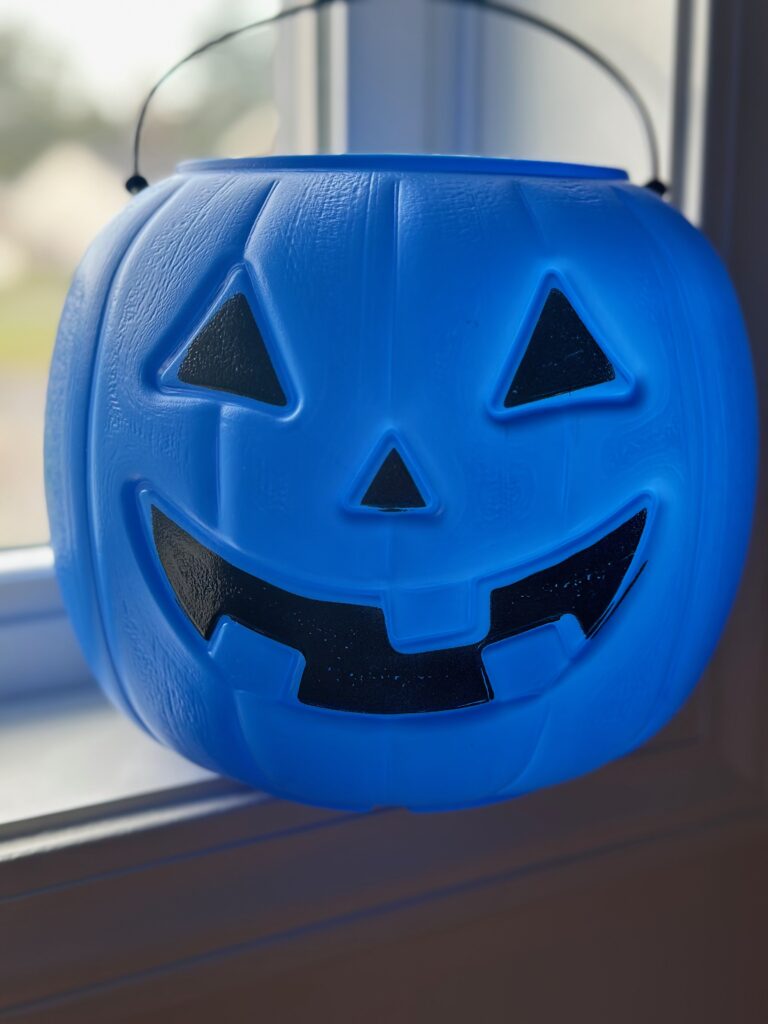ASD Spooky Season Questions and Answers: What Does a Blue Pumpkin on Halloween Mean?
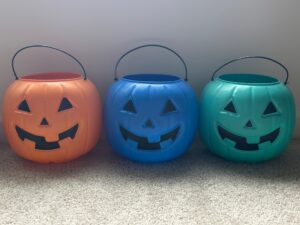 Along with the changing of the leaves, pumpkins are one of the most iconic images of autumn, especially around Halloween. Whether pumpkins are carved into Jack O’Lanterns, baked into a delicious pie, or formed into a plastic candy bucket for Trick-or-Treating, it is hard to avoid these quintessential fall classics. But more and more, some people may be noticing different colors of pumpkins out on porches, being carried by trick or treaters, or being shown on social media. That’s because, despite a pumpkin’s traditional orange color, there are some organizations and movements that rely on different colors of pumpkins to raise awareness of a particular issue or cause. This includes a blue pumpkin, prompting many people to ask what does a blue pumpkin on Halloween mean? Fear not – this horror writer and lawyer-dad explains what you need to know about a blue pumpkin to get in the true spirit of Halloween this year.
Along with the changing of the leaves, pumpkins are one of the most iconic images of autumn, especially around Halloween. Whether pumpkins are carved into Jack O’Lanterns, baked into a delicious pie, or formed into a plastic candy bucket for Trick-or-Treating, it is hard to avoid these quintessential fall classics. But more and more, some people may be noticing different colors of pumpkins out on porches, being carried by trick or treaters, or being shown on social media. That’s because, despite a pumpkin’s traditional orange color, there are some organizations and movements that rely on different colors of pumpkins to raise awareness of a particular issue or cause. This includes a blue pumpkin, prompting many people to ask what does a blue pumpkin on Halloween mean? Fear not – this horror writer and lawyer-dad explains what you need to know about a blue pumpkin to get in the true spirit of Halloween this year.
And that is a blue pumpkin, not a teal pumpkin. That’s different, and the difference is very important for many different reasons. Not just in what you should leave out in the pumpkin for trick-or-treaters, but also how you may want to conduct yourself around trick-or-treaters with different colored pumpkins. For me, the blue pumpkin as much more significance this year – more than any other year. Let’s learn a little bit more about these different colored pumpkins and why teal and blue are important.
Refreshing the Pumpkin Color Palette – Non-Traditional Pumpkin Colors, Explained
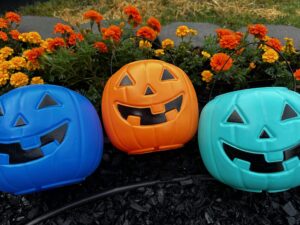 Before we talk about a blue pumpkin and its significance, we need to address teal pumpkins. That’s because teal pumpkins are undoubtedly the most popular color of non-traditional pumpkins. The credit for this goes to the Teal Pumpkin Project, which is an initiative by the Food Allergy Research and Education (FARE) organization and originally inspired by a local awareness activity run by the Food Allergy Community of East Tennessee (FACET). The purpose of a teal pumpkin on your doorstep on Halloween is meant to indicate that you have non-food treats available for children who may have food allergies.
Before we talk about a blue pumpkin and its significance, we need to address teal pumpkins. That’s because teal pumpkins are undoubtedly the most popular color of non-traditional pumpkins. The credit for this goes to the Teal Pumpkin Project, which is an initiative by the Food Allergy Research and Education (FARE) organization and originally inspired by a local awareness activity run by the Food Allergy Community of East Tennessee (FACET). The purpose of a teal pumpkin on your doorstep on Halloween is meant to indicate that you have non-food treats available for children who may have food allergies.
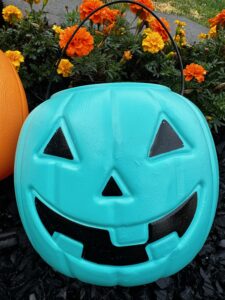 Some examples of non-food treats that you may offer include:
Some examples of non-food treats that you may offer include:
- Glow sticks, glow necklaces, or glow swords
- Crayons or markers
- Coloring books
- Toys
- Puzzles or games
- Balls (non-rubber and non-latex)
- Bubbles
- Play-Doh
- Vampire teeth
- Spider rings
- Halloween stickers
- Horror books (shameless plug-in as a horror writer!), and
- Other non-food and low allergy-risk items (i.e., nothing with latex, so no balloons or rubber toys that *might* have latex in them).
To learn more about what we are putting in our teal pumpkin this year, including pictures and links, keep scrolling below!
What Does a Blue Pumpkin on Halloween Mean?
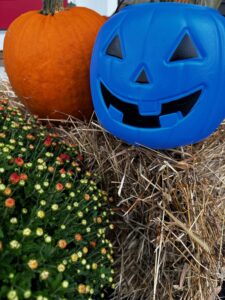 Now here is what really matters to me and my family for the first time this Halloween. In contrast to a teal pumpkin, a blue pumpkin is meant to raise awareness for children living with an autism spectrum disorder (ASD). Use of a blue pumpkin for ASD has been credited to a grassroots movement that likely started as an offshoot from other projects like the Teal Pumpkin Project by a group of parents who have children with ASD.
Now here is what really matters to me and my family for the first time this Halloween. In contrast to a teal pumpkin, a blue pumpkin is meant to raise awareness for children living with an autism spectrum disorder (ASD). Use of a blue pumpkin for ASD has been credited to a grassroots movement that likely started as an offshoot from other projects like the Teal Pumpkin Project by a group of parents who have children with ASD.
Thus, a blue pumpkin held by a trick or treater is meant to indicate that he or she has an ASD and may be nonverbal or may have difficultly communicating or interacting with you. It could also mean that the trick-or-treater is working on his or her communication skills, so be patient. Whereas a blue pumpkin on a porch or a blue pumpkin sign may indicate that a home is particularly aware of ASD and may be more inviting and understanding to trick or treaters and families.
What is Autism and ASD?
Although most people have heard of autism or ASD, it still may be one of the most misunderstood conditions out their affecting children and adults. This is true not only of others who do not know what ASD is, but also parents, grandparents, and even healthcare practitioners.
I’m no expert, but I’ve learned quite a bit in a short time about ASD since my son’s diagnosis. As a writer and lawyer, I like to think of myself as well-read and well-educated. But it turns out I had some humble [pumpkin] pie when it came to ASD and learning about it to help my family.
But the first and most important thing about Autism and ASD, it is a spectrum. Once you have met one person with ASD, you have met just one person with ASD. The condition is so broad and the symptoms are so wide-ranged, that it impacts everyone very differently. Let’s learn some more about ASD with some facts and prevalence.
Quick ASD Stats
According to the National Institute of Mental Health (NIH), ASD is defined as “a neurological and developmental disorder that affects how people interact with others, communicate, learn, and behave.” As provided for in the DSM-5 by the American Psychiatric Association (APA), individuals with ASD generally present with the following symptoms:
- Difficulty with communication with other people
- Difficulty with interaction with other people
- Restricted interests and repetitive behaviors or conduct
- Symptoms that may affect their ability to function, including in school, at work, or in other areas of their lives
Unlike a broken bone that generally has one symptom (ouch) and one prognosis (mending together), autism has a range of possible symptoms, prognosis, and impairments. This is why autism is known as a “spectrum” disorder. Generally, there are three levels of autism. Level one is the mildest classification (sometimes referred to as a “high-functioning” case of ASD), whereas level three requires the most substantial support to overcome severe challenges. Predictably, level two falls in between level one and three. It also has the greatest range of symptoms and outcomes.
What is the Prevalence of Autism?
In addition to being misunderstood, ASD may also be one of the underrecognized conditions. Which is bad, because early intervention can make a huge difference for a child.
In fact, most people are wholly unaware of the prevalence of ASD. The World Health Organization (WHO) estimates that 1 in 100 children fall somewhere on the autism spectrum. Whereas the Centers for Disease Control and Prevention (CDC) estimate that about 1 in 44 children at the age of 8 will have been identified with ASD. Even though the estimates sound far aware, the CDC’s report recognizes that some communities it studies had a rate of ASD that was 1 in 60 children (Missouri), while others were 1 in 26 children (California).
Autism can impact any race or ethnicity. Generally, it tends to impact men more than women. According to statistics from a CDC report, 1 in 27 boys were identified with ASD whereas 1 in 116 girls were identified with ASD. This becomes roughly 1% of the world’s population, or 3.5 million Americans living with Autism.
What Should I Do if I See a Child with a Blue Pumpkin on Halloween?
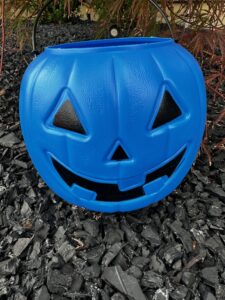 Halloween is for everyone, as is trick or treating. Many children anxiously await each year for this opportunity to evolve into something fun, scary, or finally become a prince/princess. It is important to maximize their enjoyment as much as possible, while also keeping the entire process safe and appropriate for them.
Halloween is for everyone, as is trick or treating. Many children anxiously await each year for this opportunity to evolve into something fun, scary, or finally become a prince/princess. It is important to maximize their enjoyment as much as possible, while also keeping the entire process safe and appropriate for them.
Some of the most important tips that people who see a child with a blue pumpkin on Halloween should do include the following:
Be patient, be patient, be patient, and… be patient! Patient as a Gargoyle!
Children with ASD may interact with you slower. This might because they are learning social cues and interactions. Some may need to work up some mental courage to speak out to you. Others may have difficulty recognizing appropriate cues and responding in general. Be gracious and be as patient as a mummy waiting to be discovered in the sands of Egypt. Never show frustration in a child that is trying – whether carrying a blue pumpkin or not.
Don’t be a monster – never get agitated.
Displaying any type of agitation or frustration might not only spook a child with a blue pumpkin from your doorstep, but it might send them home for the night. The Grinch isn’t part of this holiday, so don’t be one! That goes for really any child, especially young children. Be friendly to everyone. Not just for friendly’s sake, or not just because it is the right thing to do, but because you don’t want the reputation for being the nasty house on the block. Be nice to all kids, at all times, or you might find yourself on the other end of a TP roll when those little kids become bigger kids. Kindness is like a boomerang, it will come back to you if you throw it the right way.
Consider leaving a blue pumpkin out and away from your door.
Although many children with ASD may feel comfortable ringing your doorbell and interacting with you, some may not. Some may even dread just walking up to your door if you put out a bowl of candy, fearing you might open the door to say “hi.” Others may not like to be in a group or crowd of other trick or treaters, and may hesitate to march up the walkway.
One way to avoid this would be to leave a blue pumpkin out somewhere else for those with ASD to go instead that is away from your door and others. This could be at the end of your front porch, near your garage, or even in the middle of your front lawn. Illuminating it will help call attention to it, and perhaps playing a sign that indicates the treat bucket is for children with ASD or for those who may be too afraid to go up the walkway.
Do not rush a child.
Never rush a child to make a selection or move along. Some children with ASD may take a longer time to process their emotions. Other children may have a food allergy and need to select a proper snack. There’s no werewolf chasing you (probably), so don’t rush trick or treaters.
Don’t jump out or frighten children.
It might be fun to hide as a scarecrow or open your door in a gorilla costume to make trick or treaters earn their sugary bounty. But children with ASD may quickly become overstimulated and frighten in ways that may impact them for much longer into the night and way beyond your door. Don’t allow your threshold to be a harbinger of evil, and skip frightening children – especially if you see blue pumpkin on Halloween.
That doesn’t mean you can’t go run out and chase any little demon that TP’ed your house or dumped the candy bowl – go get ‘em! But leave the innocent children out of your hunt.
Don’t touch their bucket, bag, costume, or them.
Okay, this should go without saying. Especially in today’s society. But this tip does not just apply to stranger-danger situations, but also to neighbors, friends, colleagues, and even family members who are handing out candy to children they already know. Although it may be tempting to even ask for a fist-bump or high-five with a child you already know, or touch their sword or tiara, just don’t – especially if you do not normally engage in this activity. Children with ASD may be roleplaying and really enjoy their costume, while others may be using it as a shield to gain courage, and in either situation, they may simply not want to be touched. So just don’t and stay out of purgatory—in more ways than one.
Be positive and stay positive.
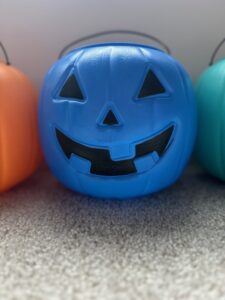 Encouraging all children in a positive light should be the standard custom, not an exception. But if you see a child holding a blue pumpkin, make sure to be particularly inviting, happy, and reinforce positive conduct and appropriate social interactions. Doing so may not only make a child happy at your doorstep, but it might make up for a cranky neighbor’s house a few doors down.
Encouraging all children in a positive light should be the standard custom, not an exception. But if you see a child holding a blue pumpkin, make sure to be particularly inviting, happy, and reinforce positive conduct and appropriate social interactions. Doing so may not only make a child happy at your doorstep, but it might make up for a cranky neighbor’s house a few doors down.
Age doesn’t matter.
If you see a child with a blue pumpkin on Halloween who may be a little old for this activity, you shouldn’t mention it. Individuals with ASD have difficulty with appropriate social interactions and what is socially acceptable. That means some individuals who may be older and outside the realm of “normal” trick or treating age may still deem it appropriate. And that’s just fine. They are having fun, it’s just one night a year, and you don’t need that extra candy anyway. Don’t pirate the night away, give up the goods and don’t ask or mention it, or ye walk the plank, argh!
Also recognize that some older individuals may be trick or treating for a younger sibling, relative, or friend who may physically or emotionally be unable to trick or treat that year. This includes children who may be sick (COVID, cancer, etc.) or injured (broken foot). Some older individuals may even have some embarrassment about doing this. Don’t make the situation more awkward than finding a zombie bite on your friend’s arm, and just go with the fun.
Use common sense.
A child with a blue pumpkin may not say trick or treat because he or she is nonverbal, and may instead just hold out the bucket. Don’t except a “trick or treat” to echo out. Instead of demanding this ceremonial ultimatum, and just drop a few treats in the bucket with a smile. This sentiment for nonverbal children has been echoed by many websites and resources, including in the remarks of Betsy Berman, former President of The Autism Resource Foundation, when reflecting on her child.
Know that some children with ASD may be able to say trick or treat, but be unsure of thanking you for your gift. That’s fine too, and send them off with well-wishes and encouragement – let their parents (who undoubtedly have tried or will try) work on that (hint, they probably are).
Ignore “irritating” or peculiar behavior.
Children with ASD may have difficulty interacting what you would deem appropriately while trick or treating. This includes not just with you, but also with other children in their group. If you see a child with a blue pumpkin acting in such a way (for example, sticking their bucket out and ahead of other children), don’t respond in a negative manner. And certainly do not “punish” the child by making him or her last. Understand what is going on and engage the child as normal.
When in doubt, look at the parents or chaperone.
If a child with a blue pumpkin does something you are unsure of, the routine should be to award candy and move on. No teachable moments please, thanks! But if you are unsure of something, look out to the parents or adult with the group of trick or treaters. They may signal or gesture to you what to do, or they may even call out. Always be respectful to the children, and realize that some parents going out trick or treating with children on the ASD may also relish in seeing their little ones happy with other children. Halloween is a magical time, where a warlock, airplane pilot, and skeleton princess can all get along. And so should you.
What You Must Put in Your Blue Pumpkin, From Our Horror Writer and Lawyer-Dad
 Tapping into my lawyer-dad mood, here is something important you need to include in your blue pumpkin. Actually, it should go in your teal pumpkin and orange pumpkin. It can go in or on any treat-or-treater bag or on your little goblin or ghoul as they run out.
Tapping into my lawyer-dad mood, here is something important you need to include in your blue pumpkin. Actually, it should go in your teal pumpkin and orange pumpkin. It can go in or on any treat-or-treater bag or on your little goblin or ghoul as they run out.
A name tag and contact information card.
Yes, this is super important in the occurrence of an emergency. Think lost child, separated, or god-forbid abducted or hurt in an accident.
The most important thing you can do is put a notecard or even an Autism sticker/info pack inside of the pumpkin with your child’s name, a note that he or she may be non-verbal, address, and contact information for you and your spouse, significant other, or another reliable adult. Teach your child to give this card to a first responder in an emergency, such as if he or she is lost.
This is particularly true if your child is non-verbal. Having a notecard here can really help you and your family in an emergency. Thus, a blue pumpkin can serve not only for collecting candy, but can be a backup in an emergency.
What is Nick Putting in his Teal AND Blue Pumpkin This Year?
Above I had listed some great options in the teal pumpkin. There are also some great options that can also go in the blue pumpkin too. Here is what I went with this year to put in my teal pumpkin and blue pumpkin on Halloween for trick-or-treaters:
Glow Sticks
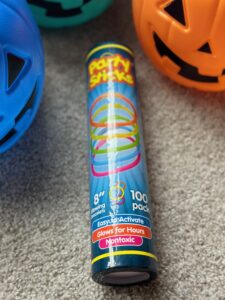 Okay who doesn’t like glow stickers? And being a lawyer-dad, I love glow sticks even more because they can help trick-or-treaters be more visible as dusk and darkness fall over the spooky festivities of Halloween. I bought this set of Glow Sticks on Amazon in a pack of 100 (I don’t get many trick-or-treaters), and they are available in other sets. (NOTE: This is an affiliate link and I may receive a commission from a direct purchase).
Okay who doesn’t like glow stickers? And being a lawyer-dad, I love glow sticks even more because they can help trick-or-treaters be more visible as dusk and darkness fall over the spooky festivities of Halloween. I bought this set of Glow Sticks on Amazon in a pack of 100 (I don’t get many trick-or-treaters), and they are available in other sets. (NOTE: This is an affiliate link and I may receive a commission from a direct purchase).
Squishy Halloween Toys
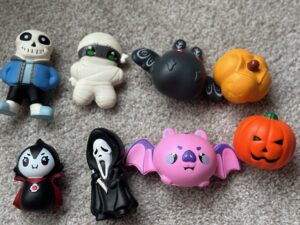 Another staple for many holidays are stress balls or squishy toys. These are also a great sensory toy! Being a horror writer and dad, I appreciated the detail on the characters in this set of 8 from Amazon (NOTE: this is an affiliate link and I may receive a commission from a direct purchase).
Another staple for many holidays are stress balls or squishy toys. These are also a great sensory toy! Being a horror writer and dad, I appreciated the detail on the characters in this set of 8 from Amazon (NOTE: this is an affiliate link and I may receive a commission from a direct purchase).
Halloween Toy Combo Pack
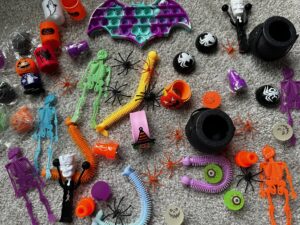 I usually like to stay away from combo packs because I think there is a lot of “filler” in there which most kids won’t like. That’s nearly unavoidable, but this pack of 54 Halloween sensatory pop pack and mini toys is of good quality from Amazon (NOTE: this is an affiliate link and I may receive a commission from a direct purchase).
I usually like to stay away from combo packs because I think there is a lot of “filler” in there which most kids won’t like. That’s nearly unavoidable, but this pack of 54 Halloween sensatory pop pack and mini toys is of good quality from Amazon (NOTE: this is an affiliate link and I may receive a commission from a direct purchase).
In it, there are many sensory toy options in fact. This includes more than just the popping toys, about also some snap, wind-up, or little wiggly toys. All great options.
Also note, that there are some things already missing from this pile… my toddler found some already and laid claim! Just be aware that some of these toys may be small for younger children, and some are definitely a choking hazard.
Halloween Lego Owl
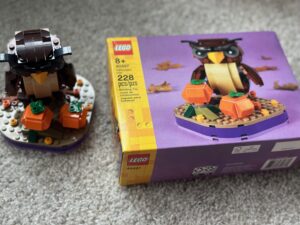 Ever hear the expression the early bird gets the worm? Well at Nick’s house, the early trick-or-treater gets the bird!
Ever hear the expression the early bird gets the worm? Well at Nick’s house, the early trick-or-treater gets the bird!
I put out one big and super toy for the first little goblin, ghoul, or witch to come by, and this year I am going with this awesome pumpkin and owl set from Lego available from Amazon. (NOTE: this is an affiliate link and I may receive a commission from a direct purchase).
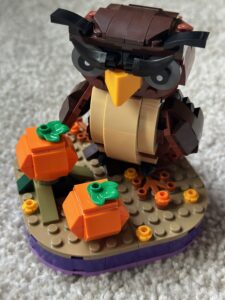 Touting 228 pieces, this is a great little boon for a trick-or-treater that gets their hands on it first. I will only put this in my blue pumpkin, so it will be a special treat for a child. Now it is important to note that there are some small pieces, but hopefully parents will realize that when they inspect their child’s bounty.
Touting 228 pieces, this is a great little boon for a trick-or-treater that gets their hands on it first. I will only put this in my blue pumpkin, so it will be a special treat for a child. Now it is important to note that there are some small pieces, but hopefully parents will realize that when they inspect their child’s bounty.
There are many other important toys and treats for kids that have allergies and need to avoid the regular bowl of confectionary wonders, but I like these four for this year.
What Can I Do to Help My Child With ASD on Halloween?
Helping a child with ASD on Halloween often starts well-before Halloween. Most parents with children who have special needs already know that if they have been through the rodeo before. But maybe this is your first Halloween trick or treating with your child who has ASD. Or maybe you tried last year and it was a flop like a gravestone. Perhaps you may even be going out with a group and one of the children has ASD. There are some important things you can do to help your child or children in your group who have ASD.
Most of these tips will echo the overarching sentiments above. That means being patient, being loving, and being gracious. Keeping personal space and distance with children who have ASD, and engaging them by encouraging certain conduct but not becoming agitated or frustrated at other conduct which might become annoying.
The Argument Against the Blue Pumpkin: Why Some People Say They Won’t Use a Blue Pumpkin for Their Child, and Reasonable Arguments Against That
 Let’s be honest here, not everyone likes the blue pumpkin idea. Although a blue pumpkin is an important awareness tool, it is not universally accepted by everyone – parent and child alike. Some parents have even outwardly said that they will not use a blue pumpkin. Many of the reasons may be important and applicable to you and your child, but some may. It is further important to realize that a blue pumpkin is just one tool, and not the be-all or end-all tool, for ASD and Halloween.
Let’s be honest here, not everyone likes the blue pumpkin idea. Although a blue pumpkin is an important awareness tool, it is not universally accepted by everyone – parent and child alike. Some parents have even outwardly said that they will not use a blue pumpkin. Many of the reasons may be important and applicable to you and your child, but some may. It is further important to realize that a blue pumpkin is just one tool, and not the be-all or end-all tool, for ASD and Halloween.
Some of the most common arguments against using a blue pumpkin on Halloween include the following:
CLAIM: I’m in charge of my children, and I’ll say that goes, and a blue pumpkin is out.
Great—that’s literally how parenting works. If you feel that a blue pumpkin isn’t right for you and your family, then you shouldn’t use it. Like the use of a teal pumpkin, or even representing or supporting other causes (i.e., cancer, ALS, etc.), you can freely choose how and if you want to promote it. There’s not legal requirement to use a blue pumpkin, so this argument seen on several blogs is a little odd.
CLAIM: I can’t be certain other people in the neighborhood will know what a blue pumpkin means, so why does it matter.
A good point. But isn’t that how movements work? No one really knew what a yellow ribbon was before there were movements to help promote it. Now there are several meanings behind a yellow ribbon and what it could mean in a certain situation. There’s no requirement to participate in the blue pumpkin for ASD awareness, so no worries to not participate. But deciding to not participate because there is not enough awareness is merely citing a problem without being a part of the solution. As a parent, lawyer, writer, and advocate, I choose to be a part of the solution — even if it may take awhile to get there; a little movement = some movement = some progress.
CLAIM: A nasty neighbor won’t care about my child’s blue pumpkin, so it doesn’t matter.
That’s true, the nasty neighbor likely won’t care about your child’s pumpkin – whether it is blue, teal, red, pink, or yes, orange. So why go to that neighbor? Why let that neighbor dictate what you do with your children? Halloween is supposed to be fun for all, especially children. If you have a nasty neighbor, then why subject your children to them? As a parent, I have no shame in skipping neighbors that may create a negative experience to my child or my group – or of course, me. Life’s too short to please everyone, and when you try to do that anyway, you’ll just end up displeasing yourself. Skip that nasty neighbor and certainly don’t let the nasty neighbor “win” by influencing the color of your pumpkin.
CLAIM: Children are mean, so I don’t want to make my child a target.
Another great point. You know the dynamic of your child and his or her situation. That situation being his or her disability, but also the makeup of your trick-or-treating group, your neighborhood, and the other relations and experiences that come with Halloween. Maybe a blue pumpkin will be great in a safe group of close friends who are accepting. But maybe in a different group – maybe people you are less familiar with – it might not work. You need to gauge that yourself. This is a valid point and requires you as a parent to exercise some discretion.
But there is something to be said about dismissing how other children will treat your child. You should expect more from them, and if you don’t get it, you need to reflect on why you bring your child around these individuals in the first place. Maybe you have no choice, and that will happen. But as an adult, you can make certain situations teachable moments. That sounds corny, but it is very important for young children. Be a leader, set the example, and help to guide – not force – others that way.
Moreover, the fact that other children may take a position that is mean to your child is just… life. It’s horrible. There is no question that bullying occurs. Some might even say it is a part of growing up, others even label it as “character-building.” I think it is just bad and unacceptable, but nearly unavoidable. So if you are afraid of bullying on your child, and it is unavoidable, wouldn’t you want to be there for support? If you are trick-or-treating with a special needs child, you likely will be. Other children can be mean, but you can be present on Halloween to dilute, mitigate, address, or entirely prevent it. Don’t let a few bad apples spoil the evening for you or your child — especially on such a hallowed day as Halloween (at least for us horror writers).
CLAIM: Labeling disabled people, especially children, is just wrong.
There’s merit to that too. Indeed, in law there are certain situations where it is unlawful to disclose another person’s medical condition or disability. However, by giving them a blue pumpkin, and presumably allowing others to see them with it (and also presumably those individuals will either know what it means or look it up), does not brand your child with some type of scarlet letter. Nor does it demand respect from others. You do that by acting that way or believing that.
Doing this can create awareness to ASD.
It allows others in the community to realize that, hey, there are people with ASD around me. Many are perfectly normal and do the same things that I do.
And if it is anything like my first impressions and indoctrination into this subject, it might also help you and others around you realize that there are a whole heck of a lot of children (and adults) with ASD. I never realized how common ASD really was until I had my eyes opened up a little bit. It even helped diffuse many of may preconceived (and incorrect) assumptions about ASD. By using a blue pumpkin on Halloween, you are helping that awareness to foster a little with the growth of this grassroots movement.
CLAIM: I shouldn’t have to divulge private and protected health information for a candy bar.
This is probably the most ridiculous of the arguments. First, have you ever seen a sticker that says cancer survivor? Or a yellow ribbon or pink ribbon? Do you think we should rip those off people too because they give up protected health information? Absolutely not. And if you do, i’m surprised you’ve made it this far down.
Second, this argument is so elementary — so small-minded, literally insignificant in cognitive reasoning it is embarrassing this argument is used with a straight face and attempted good-will. What is worse is that some people combine it with the law; I’ve seen people claim that HIPAA protects them and their children (actually I’ve seen it HIPPA, which is the wrong acronym), but HIPAA does not do such a thing — you are the holder of the information… *facepalm* If you are the type of parent that equates needing to divulge health information with getting a candy bar, I encourage you to research more opinions — both that share yours and are contrary to yours — and speak with your physician and your child’s physician about it.
Third and finally, no, you don’t have to divulge any health information to get candy. You don’t have to use a blue pumpkin. But others can, and it is their choice — not yours. By allowing them to understand that this is an option, you are allowing them to research and make their own decisions — not have your decisions forced on them.
CLAIM: I shouldn’t have to use a blue pumpkin to get kindness on Halloween.
This argument is completely right. Every homeowner should give every child respect all the time, not just on Halloween. And not just to certain kids that have disabilities or other sympathetic circumstances. But, unfortunately, we know that is not always the case — and if you disagree, it smacks of privilege. In normal communities, there are some people and homeowners that will be nasty to children that don’t present as proper and polite. Maybe creating awareness that there is a reason for not saying trick-or-treat or thank you, might give that person a second-thought. Or maybe it might not. That’s your decision as a parent who knows the circumstances of your child and the neighborhood. But it is not your decision to make for other children — including mine. Period.
My View As a Lawyer-Dad on the Blue Pumpkin
You may find yourself on either side of the blue pumpkin debate. That’s fine. Just how not everyone thinks that ABA therapy is the best for ASD, not everyone has to agree on a blue pumpkin. But come on—it’s trivial when we are facing much greater challenges. Learn both sides, do some research, and make your own decisions.
But it is important to realize that a blue pumpkin is important not just for you, your child, and others out on Halloween, but also for first responders.
As noted above, a blue pumpkin can alert a police officer or first responder that a child may not be able to ask for help or respond to calls for assistance. A child may also be nonverbal or very hesitant to interact with a police officer or first responder’s actions. But these first responders generally know how to interact and work with children who may have disabilities such as ASD, and many of them even having formal training. By having a blue pumpkin and using an Autism info card in your pumpkin (as mentioned above), it can help you and your family in the event Halloween night becomes a true nightmare in the event of an emergency.
Conclusion of What Does a Blue Pumpkin on Halloween Mean?
Spooky is as spooky does, and I hope that this information on what does a blue pumpkin on Halloween mean help educate or at least create some awareness. I’m a horror writer and lawyer, turned into a father of a wonderful child with ASD. I’m learning as everyone else what that will mean for our future. But I’m also learning that there is a future, and it is important to keep going through all of the fun moments in life—which includes Halloween.
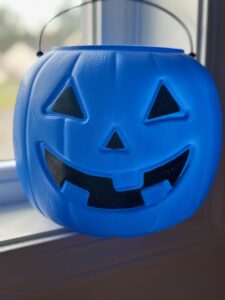 If this little blue pumpkin can help achieve that, then do it. If not, then don’t do it. This year, we will not be carrying a blue pumpkin but we will have a blue pumpkin set out with some sensory toys, candy, and other goodies, and away from the traffic of the front door. But whether you use a blue pumpkin or not, ASD can be conquered. One house at a time, one candy bar at a time, and one year at a time. Until then my friends, happy hauntings and stay safe.
If this little blue pumpkin can help achieve that, then do it. If not, then don’t do it. This year, we will not be carrying a blue pumpkin but we will have a blue pumpkin set out with some sensory toys, candy, and other goodies, and away from the traffic of the front door. But whether you use a blue pumpkin or not, ASD can be conquered. One house at a time, one candy bar at a time, and one year at a time. Until then my friends, happy hauntings and stay safe.
Did you find this helpful? PLEASE share it! Get the word out, even if someone only learns one thing from this, it is one thing that can make a huge difference. In the future, I hope to add to this page and/or create other pages which may be complimentary to this page. That includes pages about Halloween safety and trick-or-treat safety, but also pages about how to maximize the fun for your children — with a special highlight being to those with ASD.
NOTES AND DISCLAIMERS: If you found this page to be helpful, please share it share it share it. If you found something inaccurate, or if you wish to add to this page or add a link, please contact me. Media requests can be through my contact box. All photographs on this page “What does a blue pumpkin on Halloween mean” are my own, and protected by copyright. Please contact me to request usage through my contact box on my website. NOT LEGAL ADVICE. NOT MEDICAL ADVICE. NOT COUNSELING ADVICE. There is no attorney-client or patient-doctor relationship. Not an expert in any field portrayed herein. If you click on a link and purchase something, I may receive an Amazon Affiliate commission.

